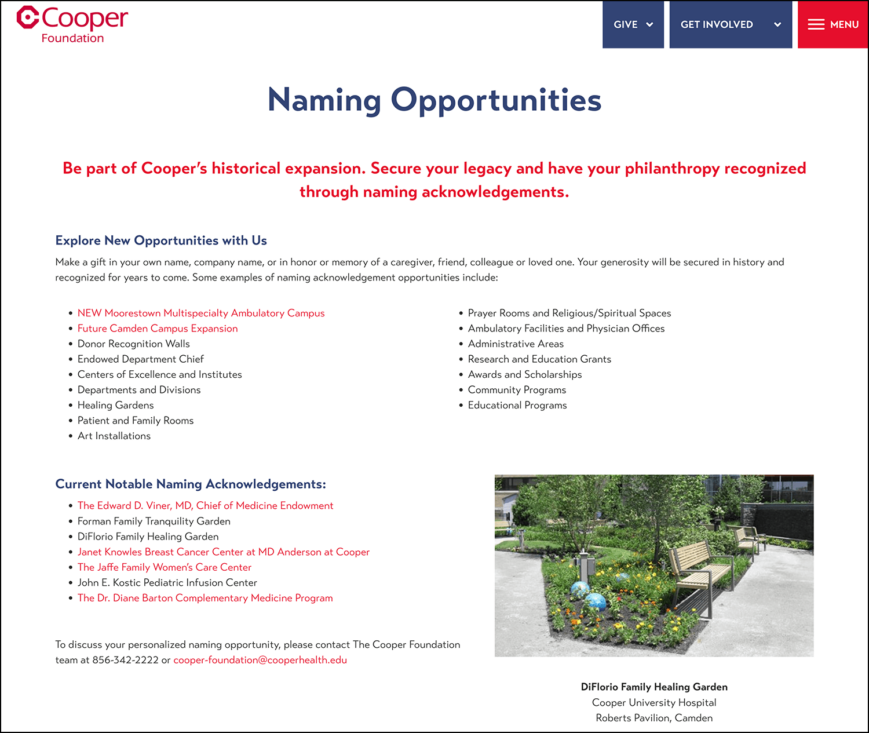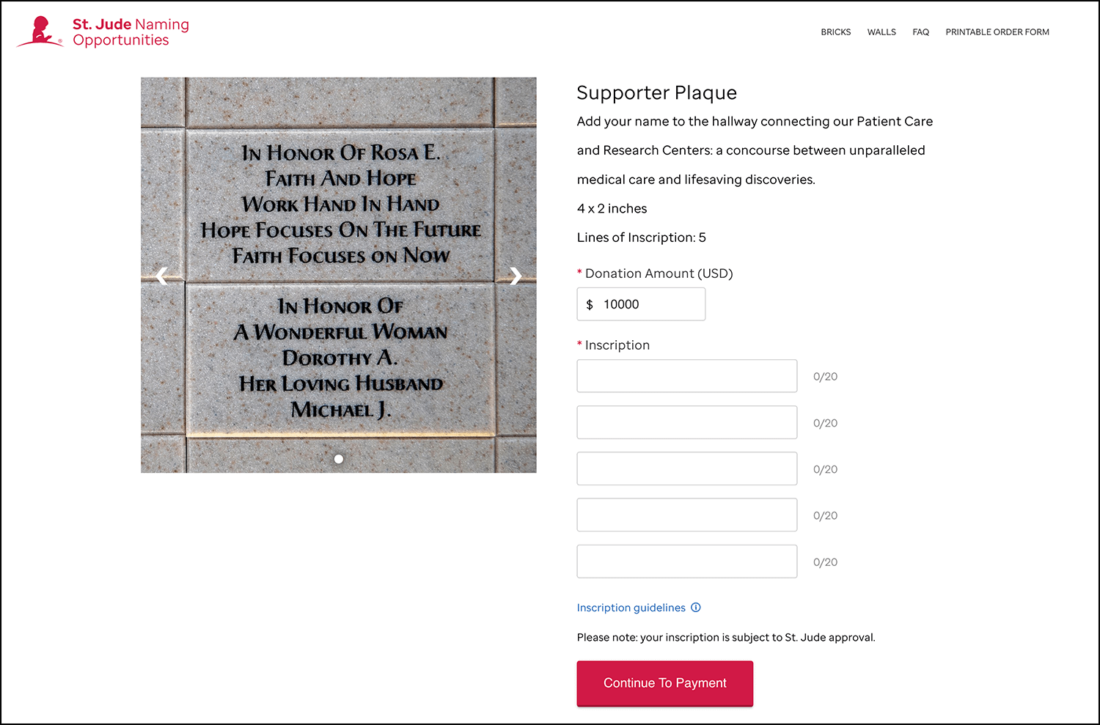How to Offer Naming Opportunities for Capital Campaigns

Imagine a donor walking through a nonprofit’s newly constructed facility. They take in the sleek, modern design of the space and imagine all the community members who will come here to tap into the organization’s wealth of programs and services.
Making their way through the halls, the donor comes to the auditorium that they specifically made a gift for during the capital campaign for the facility. They see their name proudly displayed above the doorway and feel a deep sense of satisfaction in their choice to give.
Offering naming opportunities like this for your own capital campaign can provide your nonprofit with a meaningful way to engage its supporters and honor their contributions. In this guide, you’ll learn everything you need to know to develop a donor recognition plan that includes naming opportunities:
- What is a Naming Opportunity?
- 7 Steps to Creating Inspiring Capital Campaign Naming Opportunities
- Examples of Naming Opportunities We Love
Of course, donors don’t give to capital campaigns just so they can see their name on a plaque. However, naming opportunities do make donors feel valued, and sometimes donors will give more to name a specific room, program, or space because it has special meaning to them.
Free Campaign Checklist & Guide
Download our free capital campaign checklist and guide to learn exactly what’s required for each phase of your campaign.
What is a Naming Opportunity?
A naming opportunity is a donor recognition method that allows donors to name a physical space, program, or initiative in exchange for a significant contribution.
These opportunities celebrate the donor’s generosity while advancing the nonprofit’s mission and are especially popular if you’re planning a capital campaign to renovate or build a new building.
Common Examples of Naming Opportunities
Here are some common examples of naming opportunities:
- Rooms or spaces within a building such as auditoriums, lobbies, or offices
- Outdoor areas such as gardens, walkways, or courtyards
- Physical features such as windows, benches, or flagpoles
- Programs, funds, or staff positions
- Endowment funds supporting key initiatives
The Power of Naming Opportunities in a Capital Campaign
Naming opportunities are more than a donor recognition tool. They’re a strategic and emotional driver of campaign success.
Let’s take a closer look at the benefits of naming opportunities for both nonprofits and their donors.
Benefits for Nonprofits
- Provide clear goals for different campaign giving levels. When you tie specific donation amounts to tangible outcomes (such as naming a scholarship or room), you create a structured framework that helps donors understand the impact of their gifts, which can guide their giving decisions.
- Inspire larger contributions. Donors may feel compelled to give at higher levels if it means their name will be attached to a new facility or program, especially if they are interested in leaving a lasting legacy.
- Create campaign momentum. Offering naming opportunities to major donors during the quiet phase of your campaign can help secure significant lead gifts, laying a strong foundation for the rest of the campaign.
- Strengthen donor relationships. Naming opportunities are highly visible forms of appreciation, helping your organization to build trust and goodwill with its supporters that can last well beyond a single campaign.
Benefits for Donors
- Offer lasting acknowledgment and visibility. Many forms of donor recognition, from thank-you letters to gift baskets, will be received, appreciated, and eventually forgotten. A naming opportunity creates something permanent and lasting that celebrates the donor in a highly visible way.
- Foster emotional connections to the organization’s mission. A naming opportunity provides a donor with a way to connect their personal values and identity to the mission of the organization and their campaign gift.
- Create opportunities to build a personal legacy or honor loved ones. Donors may want to leave their mark on your organization or use a naming opportunity to honor family members, mentors, or other influential figures.
7 Steps to Creating Inspiring Capital Campaign Naming Opportunities
Being strategic in how you create and offer naming opportunities for your capital campaign will help ensure that donors are excited about the opportunities and that you secure large gifts for your project.
Here are some key steps to follow:
1. Brainstorm a comprehensive list of everything that could be named.
While you can sit alone in your office and create a plan, you’ll get a better plan if you use this as an opportunity to engage key volunteers. Plus, those volunteers will start thinking about whether they might like to name a space or program in your campaign, and you’ll have a front-row seat to their growing enthusiasm.
Invite your Campaign Planning Committee or a few board members and campaign volunteers to sit around a large table with your project’s plans. Have them brainstorm every possible place in the plan that could use a name, writing each idea on a sticky note that you put on the wall. Don’t worry about the order just yet. Just put them up in a big, messy group.
Your list might include flagpoles, elevators, gardens, stairways, lobbies, or even special furnishings. A theater renovation once included little naming plaques in every restroom stall!
Your list might include your entire campus, each building on the campus, and/or the wings of those buildings. You can name office pods, entryways, and special windows. If there’s a staff lounge, that’s almost always a meaningful naming opportunity for the right donor.
If your campaign also includes endowment funds, then don’t stop with just the physical spaces. You can also include named funds within your endowment, named programs, and staff positions, too.
2. Rank your naming opportunities by “WOW” factor.
The “WOW” factor of a naming opportunity is its visibility and appeal.
While sometimes a “WOW” opportunity is a large space, it doesn’t have to be. For example, you might have a small space right at the entrance of your building — a lobby where everyone stops at the reception desk. That’s a “WOW!”
But you might have a much larger room tucked away in the back of your building where only staff members go. That one’s not such a “WOW.” (How excited would you be about a back room being named after you?)
Once you’ve listed all of your possible naming opportunities, have your group re-arrange your wall of sticky notes by “WOW” factor. It’s okay — in fact, it’s excellent — if you find yourself with several opportunities that rate roughly the same amount of “WOW.”
3. Apply giving levels to naming opportunities.
Next, take the gift range chart you’ve developed for your campaign goal. Look at each giving level and the number of gifts you need at that level to reach your goal.
It might look something like this:
| Number of Gifts | Gift Amount |
| 1 Gift | $250,000 |
| 2 Gifts | $100,000 |
| 4 Gifts | $50,000 |
| 10 Gifts | $25,000 |
| 20 Gifts | $10,000 |
Now, match the highest “WOW” factor naming opportunities to the largest gift on your chart, the second-biggest “WOWs” with the second largest gift, and so on. Here’s what your list might end up looking like:
| Number of Gifts | Gift Amount | Naming Opportunity |
| 1 Gift | $250,000 | Prominent Building Wings |
| 2 Gifts | $100,000 | Significant Rooms in Facility (e.g., conference rooms or auditoriums) |
| 4 Gifts | $50,000 | Mid-Sized Rooms, Initiatives, or Permanent Outdoor Features |
| 10 Gifts | $25,000 | Smaller Spaces, Programs, or Specific Assets |
| 20 Gifts | $10,000 | Individual Items, Plaques, or Scholarship Funds |
When this process is complete, step back and assess your list. Does it make sense and seem appropriate? Do some giving levels have many more opportunities than others? Are adjustments needed?
4. Jot down notes about the appeal of each naming opportunity.
Note the appeal of each naming opportunity so that you’ll be ready to share it with interested donors when the time comes.
Once you’ve joined your list of naming opportunities with appropriate giving levels, spend some more time brainstorming with volunteers about the impact of each space, program, or opportunity.
You may also need to engage your architects, program staff, and/or building committee to hear their input on what the spaces will look like, how they will function, and what role they will play in advancing your organization’s mission. Documenting these ideas and drafting a brief narrative description about each space will ensure you are ready and able to supply more information to potential donors if and when they express interest in a naming gift.
5. Decide if your campaign will offer traditional or innovative naming opportunities.
You may determine that a traditional approach to naming opportunities suits your organization just fine. In this approach, your donors would give the requisite amount and the space would be adorned with their names—for example, “The Smith Family Auditorium” or “The John and Sally Smith Pavilion.”
For a long time, this was the primary way organizations approached naming opportunities. Increasingly, it is not the only way.
With the innovative approach, you come up with a naming schema that reflects some aspect of your mission rather than donor names.
For example, a performing arts organization might invite donors to select and name spaces after their favorite musicians rather than themselves. The donors have choice, and yet what’s emphasized in the space is the musician, not the donor’s name (although there could certainly be a plaque in the space noting why the donor chose that specific musician!).
An Example:
Discussing the pros and cons of a traditional vs. innovative naming opportunity schema is a wonderful way to engage the members of your Campaign Planning Committee and should lead to fruitful discussions.
6. Develop, revisit, and refresh your naming opportunity policies.
Develop (or revisit and refresh) the campaign policies and gift acceptance policies around naming opportunities at your organization so that everyone knows what to expect.
Before you or others begin naming spaces in your new building, it’s a good idea to establish policies that will govern these agreements.
Consider the Following:
- What will happen if/when named spaces require renovation and additional funds must be raised to support such renovation? May new donors to the organization rename the spaces at that point?
- Or, will naming only remain in place for a certain period of time regardless of future renovations? Or, will the naming of these spaces exist in perpetuity?
- Who internally will be responsible for maintaining and repairing donor plaques if/when maintenance or repair is required?
- What happens to named spaces after a donor’s death?
- In the event of an unfortunate discovery about, say, a donor’s moral character, will the organization revisit the appropriateness of their name adorning a space or a program? If so, who will be tasked with that review? And what are the circumstances under which such a review would occur?
It is imperative that you consider and document the answers to these and similar questions as part of your naming opportunity policy. Doing so now will save your organization from headaches down the road.
7. Seek board approval for your naming opportunities plan.
Once your group of volunteers has helped you design naming opportunities and your campaign steering committee is happy with it, be sure to present it to your board (along with all the other components of your campaign plan) and ask for a formal vote of approval.
That step will save you from donors who want to negotiate the price of a space. They don’t come along often, but when they do, you want to let them know that the plan has been approved by your board and isn’t flexible.
Examples of Naming Opportunities We Love
Wondering what types of naming opportunities would be best for your organization and your donors? Get inspired by some of our favorite examples:
The Wildcat Club
The Wildcat Club is a charitable organization that supports the University of Arizona’s student athletic programs. The organization is currently running a massive capital campaign that includes renovations to several facilities and the construction of a new sports center.
The Wildcat Club offers a wide variety of naming opportunities for donors, and each opportunity is clearly laid out on the campaign website alongside the expected gift amount:

Some opportunities have already been claimed, such as the Sands Club and the Peter & Nancy Salter Head Coach’s Suite.
The Cooper Foundation
The Cooper Foundation supports the work of Cooper University Health Care in Camden, New Jersey and its surrounding areas.
The Cooper Foundation offers ongoing naming opportunities, demonstrating to donors how they can secure their individual or organizational legacy or honor a loved one by giving to support the expansion of Cooper University Health Care.
Their website features a dedicated naming opportunities page where donors can explore potential opportunities and view notable naming opportunities others have tapped into:

St. Jude Children’s Research Hospital
St. Jude Children’s Research Hospital is a nonprofit healthcare organization that specializes in treating childhood’s toughest cancers and diseases.
This is another example of an organization that offers continual naming opportunities. Donors can choose to give and put their name or the name of a loved one on a plaque in certain places within St. Jude’s facilities:

If you’re looking for a powerful way to encourage donors to give personally significant gifts to your capital campaign, offering naming opportunities is an excellent strategy to deploy. Use the guidance above to create your own naming opportunities plan tailored to your campaign, community, and mission.
Beyond Naming Opportunities: Other Capital Campaign Resources
Want to learn more about the world of capital campaigns? Check out these recommended resources:
- Capital Campaign Feasibility Study: The Ultimate Guide
- Capital Campaign Gift Range Chart: How-To Guide & Templates
- Capital Campaign Case for Support: How to Write Your Own
Get the support you need to succeed.
With our approach, you get the support, expertise, and guidance you need — plus all the tools and materials — to make your campaign a success.



Leave a Comment